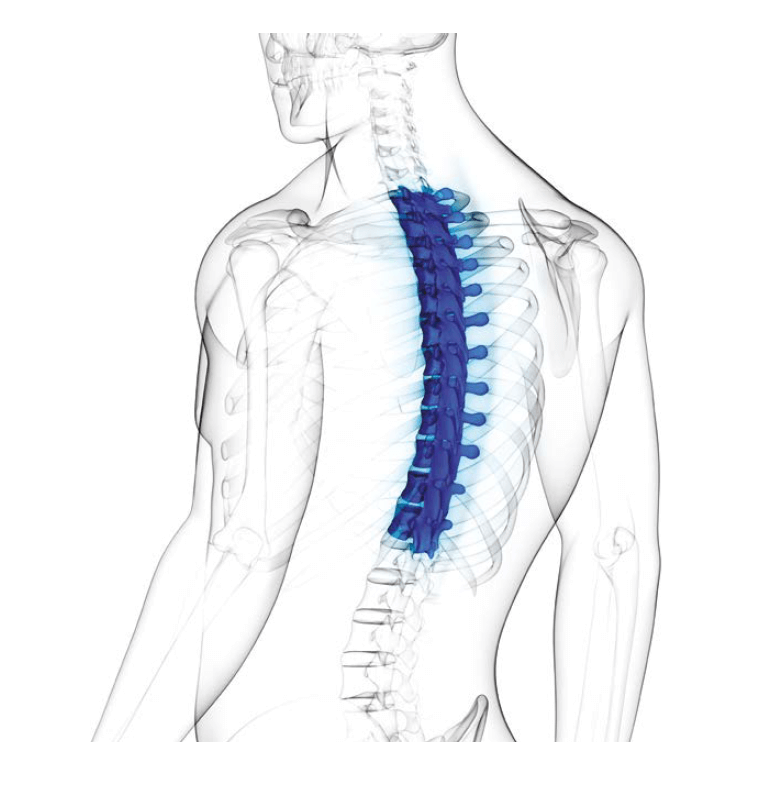There are always patients asking beside cervical and lumbar intervertebral disc herniation, are there any cases of thoracic intervertebral disc herniation? The answer is yes. How is thoracic disc herniation caused? How to prevent and alleviate it?
In fact, there is also an intervertebral disc in the middle of the human spine from the cervical vertebrae to the lumbar spine, but proportionally the herniated disc of the thoracic vertebrae is relatively rare. Why do cervical and lumbar spine often have disc herniation? The reason is that when we stand or sit down, the cervical and lumbar vertebrae will have physiological curvature changes, when the cervical spine leans forward or the lumbar spine often bends downward, the force will be located in the cervical and lumbar spine, so whether it is wear and tear or suddenly injured, the cervical spine and lumbar spine are often prone to intervertebral disc herniation. As for thoracic disc herniation, it mostly occurs in the middle of the 8th to 12th vertebrae, usually caused by posture errors. Hunchback in particular between the rib of the thoracic vertebrae and the upper lumbar spine, where there is generally more compression.

Symptoms in patients with thoracic disc herniation
The patients often describe the discomfort as follows: “The middle back position often feels painful, and the muscles will feel tense when sleeping at night, and even the front ribs will feel uncomfortable." Because the ligaments behind the spine are relaxed, the thoracic intervertebral disc may cause intervertebral disc herniation due to injury or degeneration, and it is easy to press the central nervous system when protruding, so when the patient has the problem of thoracic intervertebral disc herniation, the pain in addition to the position of the upper back and middle back, the muscles between the shoulder blade and the spine often have tension and tightening pain. Sometimes the ribs in front of the spine are uncomfortable because the thoracic spinal canal presses against the nerves. If the intervertebral disc severely compresses the spinal cord, it will also cause symptoms similar to lumbar disc herniation, which will also cause numbness, pain, fatigue, unstable walking, and cramps in the muscles of the feet. Usually, after completing the reflex or muscle test of the patient’s hands and feet, we will recommend that the patient undergo an MRI of the entire spine, from the cervical spine to the lumbar spine, to confirm whether there is a herniated disc in the spinal canal that affects the central nervous system. The treatment of thoracic discs, similar to cervical or lumbar disc herniation, is managed with conservative spinal nerve decompression. During the treatment, the patient will be advised to cooperate with exercise to relieve the nerves of the thoracic spine.
Three stretching exercises to relieve thoracic pain
First exercise
Sit on the chair, lower back against the back of the chair, feet on the floor, make sure that the knees on both sides are symmetrical, and then turn the chest and neck to the right and then return to the original position, the low back must be attached to the back of the chair during movement, the neck is relaxed, after doing 10 times, the same set of movements on the left, and the same 10 times are repeated.
Second exercise
This exercise relieves the feeling of compression and tightness in the thoracic spine section by section. Sit a little bit far, keep your ribs against the back of the chair (this is the lowest thoracic vertebrae, and the collar of the clothes is the first thoracic vertebrae), press your back to the chair, and stretch your back with your hands back, and slowly move down. The focus of this movement is on each thoracic vertebrae, so don’t stretch your chest too far.
The third exercise
This exercise stretches the latissimus dorsi. First, bend the right hand and place the left palm in the middle of the upper back, then push the left hand back with the right hand for 10 to 20 seconds before lowering it, and do not put your arms close to your ears. Then change the same movement to the other hand, the same for 10 to 20 seconds. The two sides are reversed several times.
Three exercises that strengthen the back muscles
First exercise
With your back against the wall, your feet are about one foot away from the wall, and your hands are stretched straight against the wall and sliding in the direction of your ears, as if drawing a semicircle with your hands, and then returning to the side of your body. Note that your hands must slide along the wall and repeat for 1 minute.
Second exercise
This exercise trains the muscles in the upper back and the middle of the back. First, raise your forearms so that your elbows form 90 degrees, slowly move your elbows from the front of your body to the sides, maintain your elbows at 90 degrees when moving, and then slowly return to your original position and repeat 10 to 20 times.
The third exercise
Lie on the mat with your feet open and wider than your pelvis, straighten your hands and raise your upper body as you inhale, then exhale and flex your elbows to your back and lower back, then inhale and straighten your hands, and then lie your upper body on the mat for the whole set. You can do this 10 to 20 times.

 Book an Appointment
Book an Appointment


